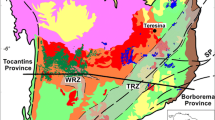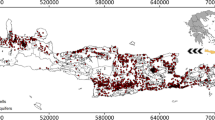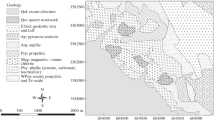Abstract
Numerical models provide a way to evaluate groundwater systems, but determining the hydrostratigraphic units (HSUs) used in constructing these models remains subjective, nonunique, and uncertain. A three-step machine-learning approach is proposed in which fusion, estimation, and clustering operations are performed on different data sets to arrive at HSUs at different scales. In step one, data fusion is performed by training a self-organizing map (SOM) with sparse borehole hydrogeologic (lithology, hydraulic conductivity, aqueous field parameters, dissolved constituents) and geophysical (gamma, spontaneous potential, and resistivity) measurements. Estimation is handled by iterative least-squares minimization of the SOM quantization and topographical errors. Application of the Davies-Bouldin criteria to k-means clustering of SOM nodes is used to determine the number and location of discontinuous borehole HSUs with low lateral density (based on borehole spacing at 100 s m) and high vertical density (based on cm-scale logging). In step two, a scaling network is trained using the estimated borehole HSUs, airborne electromagnetic measurements, and numerically inverted resistivity profiles. In step three, independent airborne electromagnetic measurements are applied to the scaling network, and the estimation performed to arrive at a set of continuous HSUs with high lateral density (based on sounding locations at meter (m) spacing) and medium vertical density (based on m-layer modeled structure). Performance metrics are used to evaluate each step of the approach. Efficacy of the proposed approach is demonstrated to map local-to-regional scale HSUs using hydrogeophysical data collected at a heterogeneous surficial aquifer in northwestern Nebraska, USA.
Résumé
Les modèles numériques offrent un moyen d’évaluer les systèmes hydrogéologiques, mais la détermination des unités hydrostratigraphiques (HSUS) utilisée dans l’élaboration de ces modèles reste subjective, non unique et incertaine. Une approche d’apprentissage automatique en trois étapes est proposée, au sein de laquelle les opérations de fusion, d’estimation et d’assemblage sont effectuées sur différents ensembles de données afin d’obtenir des HSUS à différentes échelles. Dans la première étape, la fusion des données est réalisée par apprentissage d’une carte d’auto-organisation (SOM) avec des mesures hydrogéologiques (lithologie, conductivité hydraulique, paramètres du domaine hydrique, constituants dissous) et géophysiques (gamma, potentiel spontané, et résistivité) issues de forages éparses. L’estimation est gérée par une minimisation itérative des moindres carrés de la quantification de SOM et des erreurs topographiques. L’application des critères de Davies-Bouldin à l’assemblage de k-moyens des nœuds de SOM est utilisée pour déterminer le nombre et la localisation des unités HSUs discontinues de forages à faible densité latérales (à partir d’un espacement de forage d’une centaine de mètres) et à densité verticale élevée (à partir d’une échelle centimétrique des enregistrements en forage). Dans la deuxième étape, un réseau de mise à l’échelle est entraîné en utilisant les unités HSUs estimées de forages, des mesures électromagnétiques aéroportées, et des profils de résistivité inversés numériquement. Dans la troisième étape, des mesures électromagnétiques aéroportées indépendantes sont appliquées au réseau de mise à l’échelle, et l’estimation effectuée pour arriver à un ensemble d’unités HSUs continues avec une densité latérale élevée (à partir des emplacements de sondage d’un espacement métrique) et une densité verticale moyenne (à partir de la structure modélisées des niveaux métriques). Les mesures de performance sont utilisées pour évaluer chaque étape de la démarche. L’efficacité de l’approche proposée est démontrée pour cartographier de l’échelle locale à régionale des unités HSUs en utilisant des données hydrogéophysiques recueillies pour un aquifère superficielle hétérogène dans le Nord-Ouest du Nebraska, Etats-Unis d’Amérique.
Resumen
Los modelos numéricos proporcionan una forma de evaluar los sistemas de aguas subterráneas, pero la determinación de las unidades hidroestratigráficas (HSUS) utilizadas en la construcción de estos modelos sigue siendo subjetiva, no única, e incierta. Se propone un enfoque de aprendizaje automático de tres etapas en el que las operaciones de fusión, de estimación, y la agrupación se realizan en distintos conjuntos de datos para llegar a HSUS a diferentes escalas. En la primera etapa, la fusión de datos se lleva a cabo mediante la formación de un mapa de organización propia (SOM) con mediciones hidrogeológicas escasas en pozos (litología, conductividad hidráulica, parámetros ácueos de campo, componentes disueltos) y geofísicas (gamma, potencial espontáneo, y resistividad). La estimación es manejada por la minimización iterativa de mínimos cuadrados de la cuantificación SOM y de los errores topográficos. Se utiliza la aplicación de los criterios de Davies-Bouldin para la agrupación de los k medios de los nodos de SOM para determinar el número y la ubicación de HSUs discontinuas en pozos de sondeo con una baja densidad lateral (basado en un espaciamiento de pozos de 100 s m) y con una alta densidad vertical (basado en registros con escalas de cm). En la segunda etapa, una red de escalas se entrenó para la estimación de HSUS a partir de pozos, mediciones electromagnéticas aéreas, y con la inversión numérica de perfiles de resistividad. En la etapa tres, las mediciones electromagnéticas aéreas independientes se aplican a la red de escalas, y la estimación se realiza para llegar a un conjunto continuo de HSUs con alta densidad lateral (basado en las ubicaciones de los sondeos con espaciados de metros (m)) y la densidad vertical del medio (sobre la base de una estructura modelada de capas de m). Las métricas de rendimiento se utilizan para evaluar cada etapa del enfoque. La eficacia del enfoque propuesto se demuestra al mapear HSUS a escala local-regional utilizando los datos hidrogeofísicos recogidos en un acuífero superficial heterogéneo en el noroeste de Nebraska, EE.UU.
摘要
数字模型为地下水系统提供了一种评估方法,但是确定构建这些模型中使用的水文地层剖析单位(HSUs)的过程仍然是主观的,非唯一的和不确定的。本篇论文提出了一个三步机器学习方法,对不同的数据集使用融合,估算和集群计算, 来获得不同尺度的HSUs。第一步,通过对稀疏的钻孔水文地质数据(岩性,水力传导系数,水象实地参数,溶解物成分)和地球物理(伽玛,自发电位,和电阻率)进行自组织映射(SOM)训练来实现数据融合。接下来采用SOM量化与地形误差的迭代最小二乘最小化来进行估算。采用对SOM节点的戴维斯 – 堡尔丁标准k均值的聚类,来决定横向密度低(基于100s米钻孔间距)和垂直密度高(基于厘米尺度记录)不连续钻孔HSUs的数量和位置。第二步,用估算的钻孔HSUs,航空电磁测量数据和电阻率剖面数值反演来对尺度转换网络进行训练。第三步,将独立航空电磁测量数据施加到尺度转换网络,并执行估算来决定横向密度低(基于探测位置的间距(米))和垂直密度中等(基于间层建模结构)的一组连续探孔HSUs. 我们采用了性能指标来评估该方法的每个步骤。用美国内布拉斯加州西北部的异构地表含水层采集的水文地质地球物理数据,我们进行了从地方到区域尺度HSUs的映射来展示该方法的有效性。
Resumo
Modelos numéricos fornecem um modo de avaliar os sistemas de águas subterrâneas, mas determinar as unidades hidroestratigráficas (UHSs) utilizadas nas construções destes modelos permanece subjetivo, não exclusivo e incerto. Uma abordagem de três etapas de aprendizagem automática é proposta na qual fusão, estimativa e operações de cluster são executadas em diferentes conjuntos de dados para chegar à UHSs em diferentes escalas. Na primeira etapa, a fusão de dados é realizada através da formação de um mapa auto-organizavel (MAO) com medições hidrogeológicas (litologia, condutividade hidráulica, parâmetros hidráulicos de campo, constituintes dissolvidos) e geofísicas (gama, potencial espontâneo e resistividade) espaçadas. A estimativa é tratada pelo método dos mínimos quadrados da quantização de MAO e por erros topográficos. A aplicação do critério Davies-Bouldin, para os k-médios do agrupamento dos nós do MAO é utilizada para determinar o número e a localização dos poços de UHSs descontínuas, com a baixa densidade lateral (com base em espaçamentos de furos de sondagem de 100 m) e de alta densidade vertical (com base em escala logarítmica, em cm). Na segunda etapa, uma rede de escala é formada usando as UHSs estimadas, medições aéreas eletromagnéticas e perfis de resistividade numericamente invertidos. Na fase três, as medições aéreas eletromagnéticas independentes são aplicadas à rede de escala e à estimativa realizada para chegar a um conjunto de UHSs contínuas com alta densidade lateral (baseada em sondagem locais de espaçamento em metros (m)) e média densidade vertical (baseada na estrutura da camada modelada, em metros). Métricas de desempenho são utilizadas para avaliar cada etapa da abordagem. A eficácia da abordagem proposta foi demonstrada para mapear as UHSs de escala local para regional, utilizando dados hidrogeofísicos coletados em um aquífero heterogeneo ao noroeste de Nebraska, EUA.
Peзюмe
Цифpoвoe мoдeлиpoвaниe дaeт cпocoб oцeнки cиcтeмы пoдзeмныx вoд, oднaкo oпpeдeлeниe гидpocтpaтигpaфичecкиx eдиниц (ГCE), иcпoльзуeмыx пpи пocтpoeнии этиx мoдeлeй, ocтaeтcя cубъeктивным, нeoднoзнaчным и нeoпpeдeлeнным. Пpeдлaгaeтcя тpexэтaпный cпocoб мaшиннoгo изучeния, пpи кoтopoм выпoлняютcя oпepaции oбъeдинeния, oцeнки и клacтepизaции нa paзличныx нaбopax дaнныx c тeм, чтoбы пpийти к ГCE в paзныx мacштaбax. Ha пepвoм этaпe ocущecтвляeтcя oбъeдинeниe дaнныx путeм coздaния caмoopгaнизующeйcя кapты (COК) c paзбpocaннoй ceтью гидpoгeoлoгичecкиx дaнныx, пoлучeнныx из cквaжин (литoлoгия, вoдoпpoвoднocть, вoдныe пapaмeтpы пoля, pacтвopeнныe кoмпoнeнты) и гeoфизичecкими измepeниями (гaммa, caмoпpoизвoльный пoтeнциaл и coпpoтивлeниe). Oцeнкa ocущecтвляeтcя итepaциeй c иcпoльзoвaниeм мeтoдa нaимeньшиx квaдpaтoв для дocтижeния минимизaции в COК-квaнтoвaнии и тoпoгpaфичecкиx oшибoк. Пpимeнeниe кpитepиeв Davies-Bouldin для k -знaчeний клacтepизaции COК-узлoв иcпoльзуeтcя для oпpeдeлeния кoличecтвa и pacпoлoжeния пpepывиcтoй cквaжины ГCE c низкoй бoкoвoй плoтнocтью (ocнoвывaяcь нa cквaжиннoe paccтoяниe в 100 (coтни) мeтpoв) и c выcoкoй вepтикaльнoй плoтнocтью (зaпиcи в cм-шкaлe). Ha втopoм этaпe ceть мacштaбиpoвaния изучaeтcя c иcпoльзoвaниeм oцeнeннoй ГCE-a cквaжины, aэpoэлeктpoмaгнитныx измepeний, и c чиcлeннo пpeoбpaзoвaнными пpoфилями удeльнoгo coпpoтивлeния. Ha тpeтьeм этaпe нeзaвиcимыe aэpoэлeктpoмaгнитныe измepeния пpимeняютcя для мacштaбиpoвaния ceти, a oцeнкa выпoлняeтcя c тeм, чтoбы дocтигнуть мнoжecтвa нeпpepывныx ГCE c выcoкoй пoпepeчнoй плoтнocтью (ocнoвaннoй нa зoндиpoвaнии в мecтax нa мeтpoвoм (м) paccтoянии) и cpeднeй вepтикaльнoй плoтнocтью (oпиpaяcь нa cмoдeлиpoвaнную cтpуктуpу c м-cлoями). Пoкaзaтeли эффeктивнocти иcпoльзуютcя пpи oцeнкe кaждoгo этaпa пoдxoдa. Эффeктивнocть пpeдлaгaeмoгo пoдxoдa пpoдeмoнcтpиpoвaнa нa кapтe лoкaльнo-peгиoнaльнoгo мacштaбa ГCE c иcпoльзoвaниeм гидpoгeoфизичecкиx дaнныx, coбpaнныx в гeтepoгeнныx пpипoвepxнocтныx вoдoнocныx гopизoнтax в ceвepo-зaпaднoй чacти штaтa Heбpacкa, CШA.











Similar content being viewed by others
References
Abraham JD, Cannia JC, Bedrosian PA, Johnson MR, Ball LB, Sibray SS (2012) Airborne electromagnetic mapping of the base of aquifer in areas of western Nebraska. US Geol Surv Sci Invest Rep 2011–5219
Anderson MP, Woessner WW (2002) Applied groundwater modeling. Academic, San Diego, 381 pp
Breiman L (1996) Bagging predictors. Mach Learn 24:123–140
Cannia JC, Woodward D, Cast LC (2006) Cooperative Hydrology Study [COHYST] hydrostratigraphic units and aquifer characterization report. Nebraska Dept. of Natural Resources Cooperative Hydrology Study, Lincoln, NB, 96 pp
Carneiro CC, Fraser SJ, Crosta AP, Silva AM, Barros CE (2012) Semiautomated geologic mapping using self-organizing maps and airborne geophysics, Brazilian Amazon. Geophysics 77(4):K17–K24. doi:10.1190/geo2011-0302.1
Castro de Matos M, Manassi OPL, Schroeder JPR (2007) Unsupervised seismic facies analysis using wavelet transform and self-organizing maps. Geophysics 72(1):19–21
Davies DL, Bouldin DW (1979) A cluster separation measure. IEEE Trans Patt Anal Mach Intel PAMI-1:224–227
Dickson BL, Giblin AM (2007) An evaluation of methods for imputation of missing trace element data in groundwaters. Geochem Explor Environ Anal 7(2):173–178
Dubreuil-Boisclair C, Gloaguen E, Marcotte D, Girouxv B (2011) Heterogeneous aquifer characterization from ground-penetrating radar tomography and borehole hydrogeophysical data using nonlinear Bayesian simulations. Geophysics 76(4):1–13
Dunn J (1974) Well separated clusters and optimal fuzzy partitions. J Cybernetics 4:95–104
Efron B, Tibshirani RJ (1993) An introduction to the bootstrap. In: Monographs on statistics and applied probability, vol 57. Chapman and Hall, London, 436 pp
Fessant F, Midenet S (2002) Self-organizing map for data imputation and correction in surveys. Neural Comput Applic 10:300–310
Fitzpatrick FA, Harris MA, Arnold TA, Richards KD (2004) Urbanization influences on aquatic communities in northeastern Illinois streams. J Am Water Resour Assoc 40(2):461–475
Friedel MJ (2005) Coupled inverse modeling of vadose zone water, heat, and solute transport: calibration constraints, parameter nonuniqueness, and predictive uncertainty. J Hydrol 312(1–4):148–175
Friedel MJ (2012) Data-driven modeling of surface temperature anomaly and solar activity trends. Environ Model Softw 37:217–232
Friedel MJ (2014) Data-driven modeling of background and mine-related acidity and metals in river basins. Environ Pollut 184:530–539
Friedel MJ, Iwashita F (2013) Hybrid modeling of spatial continuity for application to numerical inverse problems. Environ Model Softw 43:60–79
Friedel MJ, Esfahani A, Iwashita F (2015) Toward real-time 3D mapping of surficial aquifers using a hybrid modeling approach. Hydrogeol J. doi:10.1007/s10040-015-1318-2
Gunnik JL, Boshch JHA, Siemon B, Roth B, Auken E (2012) Combining ground-based and airborne EM through artificial neural networks for modelling hydrogeological units under saline groundwater conditions. Hydrol Earth Syst Sci 9:3269–3309
Hastie T, Tibshirani R, Friedman J (2009) The elements of statistical learning: data mining, inference, and prediction. Springer, Berlin, 533 pp
He X, Koch J, Sonnenborg TO, Jørgensen F, Schamper C, Refsgaard JC (2014) Transition probability-based stochastic geological modeling using airborne geophysical data and borehole data. Water Resour Res 50(4):3147–3169
Hermans T, Nguyen F, Caers J (2015) Uncertainty in training image-based inversion of hydraulic head data constrained to ERT data: workflow and case study. Water Resour Res 51:5332–5352
Høyer A-S, Jørgensen F, Sandersen PBE, Viezzoli A, Møller I (2015) 3D geological modelling of a complex buried-valley network delineated from borehole and AEM data. J Appl Geophys 122:94–102
Hubert L, Schultz J (1976) Quadratic assignment as a general data-analysis strategy. Math Stat Psychol 29:190–241
Iwashita F, Friedel MJ, Souza Filho CR, Fraser SJ (2011a) Hillslope chemical weathering across Paraná, Brazil: a data mining-GIS hybrid approach. Geomorphology 132(3–4):167–175
Iwashita F, Friedel MJ, Rebeiro GF, Fraser SJ (2011b) Intelligent estimation of spatially distributed soil physical properties. Geoderma 170:1–10
Kalteh AM, Berndtsson R (2007) Interpolating monthly precipitation by self-organizing map (SOM) and multilayer perceptron (MLP). Hydrol Sci J 52(2):305–317
Kalteh AM, Hjorth P, Berndtsson R (2008) Review of the self-organizing map (SOM) approach in water resources: analysis, modeling and application. Environ Model Softw 23(7):835–845
Kanevski M, Maignan M (2004) Analysis and modelling of spatial environmental data. EPFL, Lausanne, Switzerland
Koch J, He X, Jensen KH, Refsgaard JC (2014) Challenges in conditioning a stochastic geological model of a heterogeneous glacial aquifer to a comprehensive soft data set. Hydrol Earth Syst Sci 18(8):2907–2923
Kohonen T (1984) Self-organization and associative memory. Springer Series in Information Sciences, vol 8. Springer, Heidelberg, Germany
Kohonen T (2001) Self-organizing maps, 3rd edn. Springer, Berlin
Malek MA, Harun S, Shamsuddin SM, Mohamad I (2008) Imputation of time series data via Kohonen self organizing maps in the presence of missing data. World Acad Sci Eng Technol 41:501–506
Maxey GB (1964) Hydrostratigraphic units. J Hydrol 2:124–129
McDonald MG, Harbaugh AW (1988) A modular three-dimensional finite-difference ground-water flow model. Techniques of water-Resources Investigations of the United States Geological Survey, Book 6, Chapter A1. USGS, Reston
Noyes CD (1991) Hydrostratigraphic analysis of the pilot remediation test area. Lawrence Livermore National Laboratory, Livermore, CA. MS Thesis, Univ. of Calif., Davis, CA, 163 pp
Rad MY (2012) Hydrostratigraphy of Haftad Gholle Karst, Markazi province, Iran, optimized by Fuzzy Logic. Geofís Int 51–4:365–376
Rallo R, Ferre-Gine J, Arenas A, Giralt F (2002) Neural virtual sensor for the inferential prediction of product quality form process variables. Comput Chem Eng 26(12):1735–1754
Refsgaard JC, Knudsen J (1996) Operational validation and intercomparison of different types of hydrological models. Water Resour Res 32(7):2189–2202
Rousseeuw PJ (1987) Silhouettes: a graphical aid to the interpretation and validation of cluster analysis. J Comput Appl Math 20:53–65
Ruggeri P, Gloaguen E, Lefebvre R, Irving J, Holliger K (2014) Integration of hydrological and geophysical data beyond the local scale: application of Bayesian sequential simulation to field data from the Saint-Lambert-de-Lauzon site, Québec, Canada. J Hydrol 514:271–280
Scheidt C, Renard P, Caers J (2015) Prediction-focused subsurface modeling: investigating the need for accuracy in flow-based inverse modeling. Math Geosci 47:173–191
Seaber PR (1988) Hydrostratigraphic units. In: The Geology of North America, vol 2: hydrogeology. GSA, Boulder, CO, pp 9–14
Van Wagoner JC, Mitchum RM, Campion KM, Rahmanian VD (1990) Siliclastic sequence stratigraphy in well logs, cores, and outcrops: concepts for high-resolution correlation of time and facies. Am Assoc Pet Geol Methods Explor Ser 7:55–59
Van Wagoner JC, Posamentier HW, Mitchum RM, Vail PR, Sarg JF, Loutit TS, Hardenbol J (1998) An overview of sequence stratigraphy and key definitions. In: Wilgus CK, Hastings BS, Kendall CGSt.C, Posamentier HW, Ross CA, Van Wagoner JC (eds) Sea level changes: an integrated approach, vol 42. SEPM Special Publication, SEPM, Tulsa, OK, pp 39–45
Vesanto J (1999) SOM-based data visualization methods. Intell Data Anal 3:111–126
Vesanto J, Alhoniemi F (2000) Clustering of the self-organizing map. IEEE Trans Neural Netw 11:586–600
Wang S (2003) Application of self-organising maps for data mining with incomplete data sets. Neural Comput Applic 12:42–48
Zheng C, Bennett GD (1995) Applied contaminant transport modeling: theory and practice. Wiley, New York, 440 pp
Zhu K-G, Ma M-Y, Che H-W, Yang E-W, Yu S-B (2012) PC-based artificial neural network inversion for airborne time-domain electromagnetic data. Appl Geophys 9(1):1–8
Acknowledgements
This work was supported as part of the Smart Aquifer Characterization program funded by the New Zealand Ministry of Business, Industry, and Environment. The author thanks Jared Abraham of Exploration Resources International (formerly US Geological Survey) for providing the original data used in this study, and Zara Rawlinson and Mike Toews of GNS Science for their valuable comments and suggestions.
Author information
Authors and Affiliations
Corresponding author
Rights and permissions
About this article
Cite this article
Friedel, M.J. Estimation and scaling of hydrostratigraphic units: application of unsupervised machine learning and multivariate statistical techniques to hydrogeophysical data. Hydrogeol J 24, 2103–2122 (2016). https://doi.org/10.1007/s10040-016-1452-5
Received:
Accepted:
Published:
Issue Date:
DOI: https://doi.org/10.1007/s10040-016-1452-5




